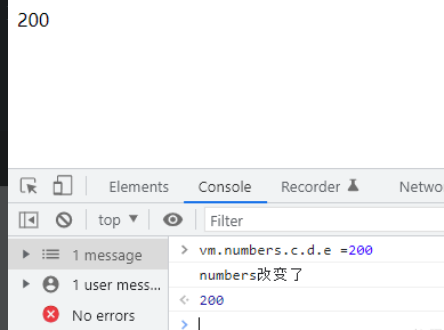1 method 实现
1
2
3
4
5
6
7
8
9
10
11
12
13
14
15
16
17
18
19
20
21
22
23
24
25
26
| <div id="root">
<h3>今天天气很{{ info }}</h3>
<button @click="changeWeather">切换天气</button>
</div>
<script type="text/javascript">
Vue.config.productionTip = false;
const vm = new Vue({
el:'#root',
data:{
isHot:true,
},
computed:{
info(){
return this.isHot ? '炎热' : '凉爽'
}
},
methods: {
changeWeather(){
this.isHot = !this.isHot
}
}
})
</script>
|

2 watch 实现
监视属性 watch:
- 当被监视的属性变化时, 回调函数自动调用, 进行相关操作
- 监视的属性必须存在,才能进行监视,既可以监视
data,也可以监视计算属性
- 配置项属性
immediate:false,改为 true,则初始化时调用一次 handler(newValue,oldValue)
- 监视的两种写法:
new Vue 时传入 watch: {} 配置- 通过
vm.$watch() 监视
第一种写法
1
2
3
4
5
6
7
8
9
10
11
12
13
14
15
16
17
18
19
20
21
22
23
24
25
26
27
28
29
30
31
32
33
|
<div id="root">
<h2>今天天气很{{ info }}</h2>
<button @click="changeWeather">切换天气</button>
</div>
<script>
const vm = new Vue({
el:'#root',
data:{
isHot:true,
},
computed:{
info(){
return this.isHot ? '炎热' : '凉爽'
}
},
methods: {
changeWeather(){
this.isHot = !this.isHot
}
},
watch:{
isHot:{
immediate: true,
handler(newValue, oldValue){
console.log('isHot被修改了',newValue,oldValue)
}
}
}
})
</script>
|
第二种写法
1
2
3
4
5
6
7
8
9
10
11
12
13
14
15
16
17
18
19
20
21
22
23
24
25
26
27
28
29
30
31
32
|
<div id="root">
<h2>今天天气很{{ info }}</h2>
<button @click="changeWeather">切换天气</button>
</div>
<script>
const vm = new Vue({
el:'#root',
data:{
isHot:true,
},
computed:{
info(){
return this.isHot ? '炎热' : '凉爽'
}
},
methods: {
changeWeather(){
this.isHot = !this.isHot
}
}
});
vm.$watch('isHot',{
immediate:true,
handler(newValue,oldValue){
console.log('isHot被修改了',newValue,oldValue)
}
})
</script>
|
3 深度侦听
- Vue 中的 watch 默认不监测对象内部值的改变(一层)
如 obj:{name:’ds’,age:18} 这里的一层指的后面整个对象字面量,而不是里面的值是第一层
- 配置
deep:true 可以监测对象内部值改变(多层)
备注:
- Vue 自身可以监测对象内部值的改变,但 Vue 提供的 watch 默认不可以
- 使用 watch 时根据数据的具体结构,决定是否采用深度监视
1
2
3
4
5
6
7
8
9
10
11
12
13
14
15
16
17
18
19
20
21
22
23
24
25
26
27
28
29
30
31
32
33
34
35
36
37
38
39
40
41
42
43
44
45
| <title>天气案例_深度监视</title>
<script type="text/javascript" src="../js/vue.js"></script>
<div id="root">
<h3>a的值是:{{ numbers.a }}</h3>
<button @click="numbers.a++">点我让a+1</button>
<h3>b的值是:{{ numbers.b }}</h3>
<button @click="numbers.b++">点我让b+1</button>
<button @click="numbers = {a:666,b:888}">彻底替换掉numbers</button>
{{numbers.c.d.e}}
</div>
<script type="text/javascript">
Vue.config.productionTip = false;
const vm = new Vue({
el: '#root',
data: {
isHot: true,
numbers: {
a: 1,
b: 1,
c: {
d: {
e: 100
}
}
}
},
watch: {
handler(){
console.log('a被改变了')
}
} */
numbers: {
deep: true,
handler() {
console.log('numbers改变了')
}
}
}
})
</script>
|

4简写
如果监视属性除了 handler 没有其他配置项的话,可以进行简写
1
2
3
4
5
6
7
8
9
10
11
12
13
14
15
16
17
18
19
20
21
22
23
24
25
| <div id="root">
<h3>今天天气很{{ info }}</h3>
<button @click="changeWeather">切换天气</button>
</div>
<script type="text/javascript">
Vue.config.productionTip = false;
const vm = new Vue({
el: '#root',
data: {isHot: true,},
computed: {info() {return this.isHot ? '炎热' : '凉爽'}},
methods: {changeWeather() {this.isHot = !this.isHot}},
watch: {
isHot(newValue, oldValue) {
console.log('isHot被修改了', newValue, oldValue)
}
}
})
</script>
|
监视到 isHot 改变会自动调用 handler 方法
5 computed 和 watch 之间的区别
- computed 能完成的功能,watch 都可以完成
- watch 能完成的功能,computed 不一定能完成,例如:watch 可以进行异步操作
两个重要的小原则:
- 所被 Vue 管理的函数,最好写成普通函数,这样 this 的指向才是 vm 或 组件实例对象
- 所有不被 Vue 所管理的函数(定时器的回调函数、ajax 的回调函数等、Promise 的回调函数),最好写成箭头函数,这样 this 的指向才是 vm 或 组件实例对象
比如想延迟一秒显示fullName,只能用watch实现
1
2
3
4
5
6
7
8
9
10
11
12
13
14
15
16
17
18
| new Vue({
el:'#root',
data:{
firstName:'张',
lastName:'三',
fullName:'张-三'
},
watch:{
firstName(val){
setTimeout(()=>{
this.fullName = val + '-' + this.lastName
},1000);
},
lastName(val){
this.fullName = this.firstName + '-' + val
}
}
})
|

